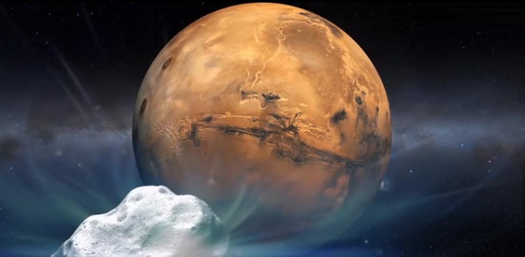Chandra Awaits Comet Siding Spring's Approach to Mars
On October 19th, Chandra will join with telescopes across the world, in orbit around Earth, and even on and around Mars, as Comet Siding Spring makes an extremely close approach to the Red Planet.

This is an extremely exciting event because scientists have determined this comet has been traveling for maybe a million years from the distant Oort Cloud. This will be the first time that humans have ever captured images of a comet from the Oort Cloud, which is an enormous reservoir of left over debris from the formation of the Solar System. (Previous observations and spacecraft visits of comets came from those that originated in the much closer Kuiper Belt.)
As Comet Siding Spring advances toward Mars, it will be moving extremely fast since it is going in the opposite direction from the Red Planet in its orbit. It will also come incredibly close to Mars. At its nearest point, the comet’s distance will be equivalent to only a third of the way between Earth and Moon.
The passage will be so close that Mars will be in the outer atmosphere, or coma, of the comet. Gas molecules and dust particles in this coma could interact with the Martian atmosphere and orbiting spacecraft, and, if large enough, could even make it down to the surface of the planet.
Expansion of the upper Martian atmosphere should increase its cross section to the solar wind, and thus its ability to emit X-rays as Martian atmosphere gas molecules charge exchange with highly-charged solar wind ions. Scientists will be monitoring Mars with Chandra, looking for just such an increase, from 4 hours before closest approach to 11 hours after. Scientists will also be using Chandra to watch the comet from 4 hours before to 6 hours after closest approach to search for its own interaction with the solar wind and any changes caused by its traversing the near-Mars solar wind structure and having Mars travel through its outer coma.
Scientists know that both objects emit X-rays, so they expect to observe a small Chandra signal from each in the 11 hours (54,000 seconds) of observation time. Any increase in these signals due to the comets close flyby should tell us something about their interaction. In a cross-platform coordinated program, the researchers will also be using the Hubble Space Telescope to monitor the Martian aurora, a measure of the planet’s exospheric excitation, as well as the comet's gas production rate, which drives both its X-ray production and its mass/energy input into the Martian atmosphere.
Researchers expect it will take a few days at least to process and analyze the Chandra data after it is obtained on October 19th. Keep checking our website and blog and we’ll post any information as soon as it’s available.
Megan Watzke, CXC
FULL STORY: http://science.nasa.gov/science-news/science-at-nasa/2014/09oct_cometprep/
Please note this is a moderated blog. No pornography, spam, profanity or discriminatory remarks are allowed. No personal attacks are allowed. Users should stay on topic to keep it relevant for the readers.
Read the privacy statement
